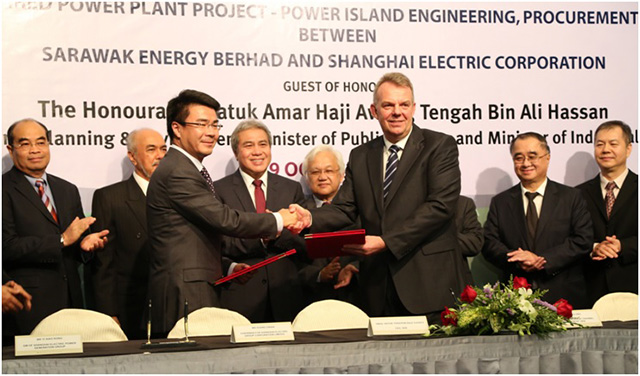

NEWS & UPDATES
Sarawak Energy inks contract with Shanghai Electric for the Construction of 2 x 300MW BALINGIAN Coal-fired Main Power Plant
KUCHING, 9th OCTOBER, 2014, THURSDAY: Sarawak Energy today entered into a contract with one of China’s leading electrical equipment manufacturing conglomerates, Shanghai Electric Group Co Ltd (SEC), for the construction of the Balingian Coal-fired Power Plant Project.
The contract will see SEC undertaking the construction of the 2 x 300MW Balingian Coal-fired Main Power Plant, the first coal-fired plant with CFB (Circulating Fluidized Bed) boiler of this capacity in Malaysia.
In comparison with conventional Pulverized Coal (PC) boiler technology, CFB boilers have the ability to handle a wide range of coal designs, including high moisture coal which is commonly found in Balingian, to ensure total utilization of the resource. This is improving the environment foot print of the plant significantly.
Second Planning and Resource Management Minister Datuk Amar Awang Tengah Ali Hasan, who is also Public Utilities Minister, witnessed the signing of the contract between three parties namely Sarawak Energy, SEC and Shanghai Electric Power Generation (M) Sdn Bhd (SEPG), which is a wholly owned Malaysian subsidiary of SEC, at a ceremony held at Hilton Hotel here today.
Signing for Sarawak Energy were its Chief Executive Officer Datuk Torstein Dale Sjotveit and its Senior Vice President of Thermal Department Mr James Ung while signing for SEC were its Chairman Mr Huang Dinan and General Manager of Shanghai Electric Power Generation Group, EPC Mr Yi Xiao Rong. For SEPG, it was signed by Director Mr Wen Weihua and Shanghai Electric Power Generation Group, EPC Vice-Chief Engineer Mr Qiu Minghua.
The contract is valued at around RM1.5 billion and the construction of the main power plant will commence next month.
A comprehensive procurement process was undertaken in accordance with Sarawak Energy’s internal procurement procedures and in alignment with recognised industry best practices to identify the tender offer representing ‘best value’ and designed to maximize local content and knowledge transfer to local companies.
The Selection of Contractor for the package commenced with market survey where thereafter proceeded with invitation and pre-qualification of international EPC contractors with CFB boiler works experience.
SEC is one of the largest equipment manufacturing conglomerates in China and possesses a comprehensive provision of modern, complete equipment sets and engineering works contracting. Since the 1990s, SEC’s sales revenue has ranked top 3 in the Chinese equipment manufacturing industry. The company has undertaken power plant projects on Engineering, Procurement and Construction (EPC) basis, both in China and abroad with more than 20 years of experience and has achieved continuous enhancement in its core competitiveness and independent innovation capability.
In his speech, Datuk Amar Awang Tengah said the demand for energy in the region records a steady increase of 3% to 4% a year but in Sarawak, there would be an expected rapid growth in power demand from the earlier 1,250MW to more than 5,000MW by 2020.
He said the rapid growth was due to the large demand from the committed and future energy-intensive industries expected to set up within SCORE and the increase in local domestic, commercial and industrial organic customers.
“Sarawak is blessed with indigenous hydro, coal and gas energy resources which give Sarawak the comparative advantage to produce bulk power at globally competitive power prices to encourage investment here. The development of these indigenous resources which is within the state’s control and not subjected to international market price fluctuation will ensure price stability for the SCORE customers and local organic customers.
“With the strategy to utilize local coal and hydropower resources, the State and Sarawak Energy are confident to meet the rapid demand growth for power and realize the state’s SCORE agenda. This is necessary if we are to achieve a high income status for our people of Sarawak by 2020 and uplift the living standards including the rural communities,” he added.
Awang Tengah said with the power generation fully developed to meet the demand in 2020, the generation capacity mix was expected to comprise 60% hydro, 20% coal and 20% gas.
“The construction of a new power plant in Balingian will also open up more opportunities especially for the locals. Their income is expected to improve with the growth of businesses in Balingian as the economic activities increase. The Balingian Coal-fired plants will also trigger socio-development in terms of generating job opportunities in the semi-skilled and skilled professions,” he added.
Commenting on the partnership in realizing this significant development trigger project, Datuk Torstein said the Balingian Power Plant would help enhance the State Grid System, particularly to meet the demand from the Sarawak Corridor of Renewable Energy (SCORE) customers.
“With an adequate and stable supply in place, we will be able to further convince investors to bring their businesses here to Sarawak to strengthen the State’s economy.
“We are having multiples discussions with potential new investors who would choose Sarawak as their preferred destination for their business operations and we anticipate encouraging response from more energy intensive industry players in the time to come,” he added.
Located in Balingian, Mukah, the whole project consists of a total of nine work packages namely the construction of the main power plant, plant site earthworks, upgrading of the access road, administration and ancillary buildings, operator’s village, the 33kV supply, 275kV EHV Substation, 275kV Transmission lines and ash pond.
The whole development of Balingian Coal-Fired Power Plant consist of nine work packages of which, about 45% will be undertaken by local contractors.
Earthworks and the upgrading of the access roads have already begun in May this year and these works have been undertaken by Sarawakian contractors.
The whole works is expected to complete in the first quarter of 2018 with the first power expected to generate by the end of 2017.

